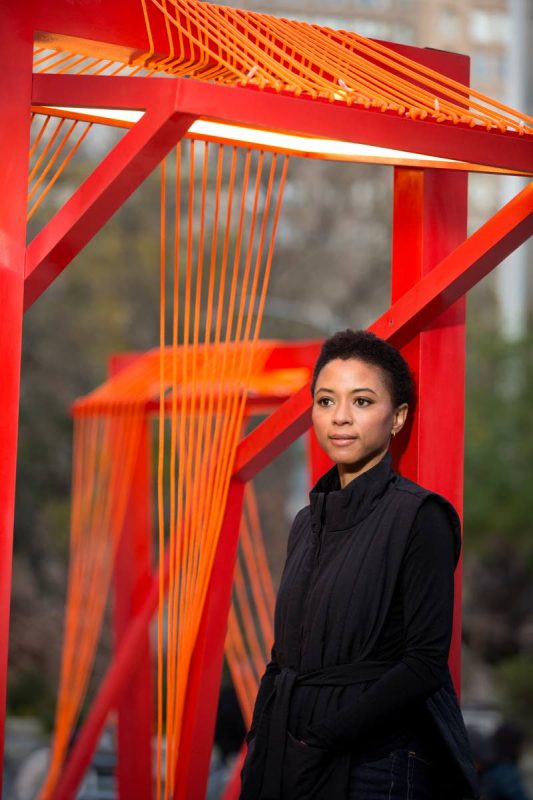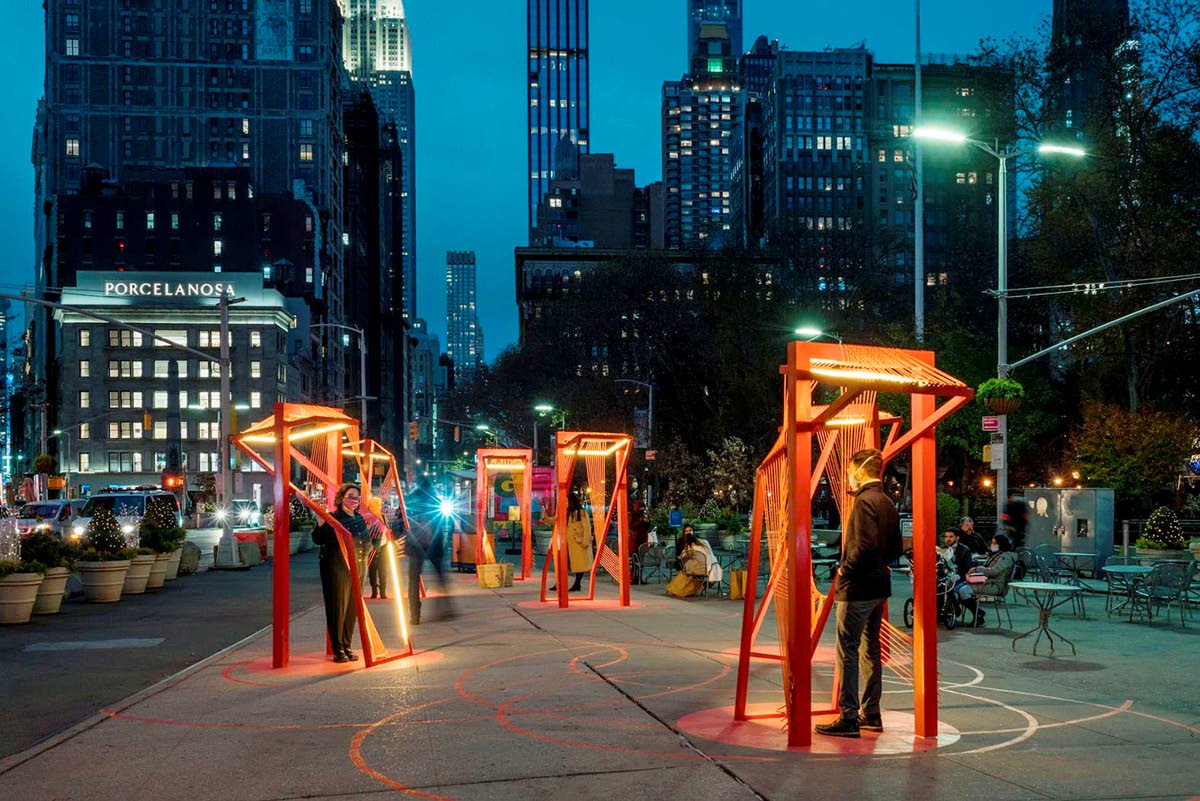Manhattan’s usually busy Flatiron district will come alive with a different energy this holiday, as visitors and residents alike interact with its latest exhibition designed by Jamaica-born architect, Nina Cooke John.
Her work – ‘Point of Action’– through her firm Studio Cooke John, was selected by organisers Van Alen Institute and the Flatiron/23rd Street Partnership from a shortlist of seven firms, as the choice piece in its annual competition earlier this year.
The project is currently on view through January 1, 2021, in the Flatiron Public Plazas on Broadway, Fifth Avenue, and 23rd Street in Manhattan, New York, and marks the first time that a designer’s work will be on show in the north and south public plazas on both sides of 23rd Street.
It is open daily to the public, and showcased as part of attractions for its ‘23 Days of Flatiron Cheer’.
Tasked with engaging public spaces to encourage bonding and networking, Cooke John says, “My hope is that ‘Point of Action’ makes people think about how we connect to the people we see every day, so that we can move forward together.”

The installation: ‘Six-foot circles affixed onto the Flatiron Public Plazas create nine ‘spotlights’, each with its own vertical metal frame. Ropes weave through each frame and part, like a curtain figuratively pulled aside, to make room for the viewer to take the spotlight, connect with other viewers across the plazas, and take action as they move out and beyond. Lighting emitted from a halo above each circle strengthens the framing; lights embedded into the sides of each frame add another layer to the viewer.”
A Campion College alum in her native Jamaica, Cooke John earned her Bachelor of Architecture degree from Cornell University and a Master of Science in Advanced Architectural Design from Columbia University. She taught architecture and design strategy at Syracuse University, and currently at Parsons the New School for Design. She has been a registered architect since 2000 holding licences in New York, New Jersey, and Connecticut.
Here, she talks about her influences, the significance of the project, and missing a traditional Jamaican Christmas during the pandemic.
GA: Congratulations on being selected for this year’s Flatiron Public Plaza Design Installation. The selectors have noted that ‘Point of Action’ by Studio Cooke John, “offers the neighbourhood continuity as we consider how public space can develop bonds and networks that help our city heal and thrive”.
How significant is this project for you, though? What does it mean for your presence in Manhattan/US going forward?
Cooke John: This project is very significant for me. Though most of my recent work has been in residential architecture, I’ve always been interested in doing more public engagement work. Public space is where people strengthen their relationships as neighbours and members of a community. This is the first project of mine that takes the design details that I usually create for my private clients into the street, giving access to great design to everyone. The Flatiron Plaza is located in a prominent spot in Manhattan, at the crossroads of businesses, residences, and universities. I could not be happier for this project to be in this location.
GA: What is the particular style that defines your work, and what are your influences?
Cooke John: My work is modern. I use clean lines to respond to contextual influences, whether that is the needs of the family, the physical location, or the recent and past cultural history of the place.
GA: Tell us about your Jamaican background, and how much of this influences your work.
Cooke John: Jamaica and Jamaicans continue to be influential in how I see architecture. Jamaicans are incredibly innovative. ‘Tun yuh han’ mek fashion’ is a phrase I turn back to often. It is an innovation born from taking what you have, and not just making it serve your needs, but doing so creatively. The resulting layered effect that we see in zinc houses, juice carts, and in clothing, is beautiful to me. It also reflects the complex and layered history of the country and its people. I draw upon this often, and did so, in particular, in my undergraduate thesis as I looked to create public space for Jamaican immigrants in New York City.
GA: You have worked on or assisted with government projects in Jamaica. Which stands out in your mind, and why?
Cooke John: My brother and I entered the competition for the Jamaica Parliament a few years ago. We had to consider how putting a building that represents our governmental structure in a public park affects how connected people feel to their government, and the accessibility of government that serves the people while at the same time taking into consideration issues of security. It was very satisfying getting reacquainted with the history of the context in Heroes’ Park and the workings of the Jamaican Parliament.
GA: What are you missing about Jamaica or home now – and how will the holidays be different for you this year?
Cooke John: I could definitely do with a nice long day on a beach right now. Add some fried fish and bammy and all the woes of 2020 would be close to erased in my mind. We usually have a very large family gathering at our house on Christmas Day, combining my Jamaican family that lives close by with my husband’s Vincy family. The table is spread with ham, sorrel, and Christmas pudding from both countries vying for prominence. We will really miss the house being filled with laughter and reconnection this year, as it will just be our immediate family. We’ll definitely still connect with everyone virtually at some point during the evening, as it just won’t be Christmas without the extended family.






